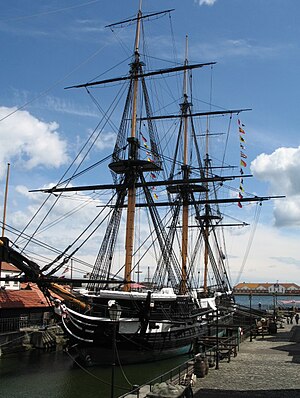Loading AI tools
19th-century British Royal Navy frigate From Wikipedia, the free encyclopedia
HMS Trincomalee is a Royal Navy Leda-class sailing frigate built shortly after the end of the Napoleonic Wars. She is now restored as a museum ship afloat in the National Museum of the Royal Navy, Hartlepool, England.
 Trincomalee in her current location in Hartlepool | |
| History | |
|---|---|
| Name | HMS Trincomalee |
| Operator | National Museum of the Royal Navy |
| Ordered | 30 October 1812 |
| Builder | Wadia Group |
| Cost | £23,000 |
| Laid down | 25 April 1816 |
| Launched | 12 October 1817 |
| Out of service | 1986 |
| Renamed |
|
| Homeport | National Museum of the Royal Navy, Hartlepool, England |
| Status | Museum ship |
| General characteristics | |
| Class and type | Leda-class frigate |
| Tons burthen | 1065.63 bm |
| Length |
|
| Beam | 39 ft 11.25 in (12.1730 m) |
| Depth of hold | 12 ft 9 in (3.89 m) |
| Sail plan | Full-rigged ship |
| Complement | 315 officers and men |
| Armament |
|
Trincomalee is one of two surviving British frigates of her era—her near-sister HMS Unicorn (of the modified Leda class) is now a museum ship in Dundee. After being ordered on 30 October 1812, Trincomalee was built in Bombay, India, by the Wadia family[1] of shipwrights in teak, due to oak shortages in Britain as a result of shipbuilding drives for the Napoleonic Wars. The ship was named Trincomalee after the 1782 Battle of Trincomalee off the Ceylon (Sri Lanka) port of that name.
Work on the Trincomalee began in May 1816. Ceremonially an engraved silver nail was hammered into the ship's keel by the master shipbuilder Jamsetjee Bomanjee Wadia, this being considered vital for the ship's well-being, according to Parsi Zoroastrian tradition.[2] With a construction cost of £23,000 (approximately £2,015,000 in 2020), Trincomalee was launched on 12 October 1817. Commander Philip Henry Bridges sailed her to Portsmouth Dockyard, where she arrived on 30 April 1819, with a journey costing £6,600.[3] During the maiden voyage the ship arrived at Saint Helena on 24 January 1819, where she stayed for 6 days, leaving with an additional passenger, a surgeon who had attended Napoleon at Longwood House on the island, Mr John Stokoe.[4]
After being fitted out at a further cost of £2,400, Trincomalee was placed in reserve until 1845, when she was re-armed with fewer guns giving greater firepower, had her stern reshaped and was reclassified as a sixth-rate spar-decked corvette.[5]
Trincomalee departed from Portsmouth in 1847 and remained in service for ten years, serving on the North America and West Indies Station. During her time, she was to help quell riots in Haiti and stop a threatened invasion of Cuba, and serve on anti-slavery patrol. In 1849, she was despatched to Newfoundland and Labrador before being recalled to Britain in 1850. In 1852 she sailed to join the Pacific Squadron on the west coast of America,[6] and upon returning to England in 1857, she was put back 'in ordinary' after arriving at Chatham on 4 September.[2]
In 1860 Trincomalee was fitted out and then in January 1861 towed to Sunderland to become tender to the drill ship HMS Castor (1832), whose role was to train Naval Volunteers boys aged 15 to 16 years being signed up to serve for 10 years on reaching the age of 18 years. During this time Trincomalee's gunports were again modified several times to accommodate different types of training armament. Then in 1862 she was moved to West Hartlepool, then the third largest port in Britain, and moored in the Union Dock to become an independent drill ship.[2]
Trincomalee finished her Royal Navy service as a training ship, but was placed in reserve again in 1895 and sold for scrap two years later on 19 May 1897. She was then purchased by entrepreneur Geoffry Wheatly Cobb, restored, and renamed Foudroyant in honour of HMS Foudroyant, his earlier ship that had been wrecked in 1897.[7]
She was used in conjunction with HMS Implacable as an accommodation ship, a training ship, and a holiday ship based in Falmouth, then Milford Haven.[8] The relocation caused great dismay in Falmouth.[9]
She remained in service until 1986, after which she was again restored and renamed back to Trincomalee in 1992.[10]

Now listed as part of the National Historic Fleet, following her recent restoration Trincomalee has become the centrepiece of the National Museum of the Royal Navy based in Hartlepool.
Trincomalee holds the distinction of being the oldest British warship still afloat[11] as HMS Victory, although 52 years her senior, is in dry dock.
Until his death in 1929, the Falmouth-based painter Henry Scott Tuke used the ship and its trainees as subject matter.[citation needed]
Seamless Wikipedia browsing. On steroids.
Every time you click a link to Wikipedia, Wiktionary or Wikiquote in your browser's search results, it will show the modern Wikiwand interface.
Wikiwand extension is a five stars, simple, with minimum permission required to keep your browsing private, safe and transparent.